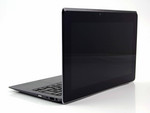Asus Taichi 21-CW001H
Spécifications de l'ordinateur portable

Price comparison
Moyenne de 8 notes (à partir de 9 critiques)
Critiques pour le/la Asus Taichi 21-CW001H
Revolutionary. One device designed for all jobs. Browsing, presentations, typing, mobility and working with a partner. The simple idea of installing a dual-TFT on the front and rear is to revolutionize using a Windows PC.
Source: APC Mag
 EN→FR Archive.org version
EN→FR Archive.org versionWe’re used to seeing interesting designs when it comes to Windows 8 tablets and convertibles, but the Taichi takes the cake for originality.We’re not sold on the idea of twin displays and it’s obviously come at the cost of other components. If you can find a good reason to use both screens, there’s nothing else quite like the Taichi, although it feels more of a proof of concept than a usable solution.
Critique simple, disponibles en ligne, Courte, Date: 04/09/2013
Notes: Note globale: 70%
Source: Computer Shopper
 EN→FR Archive.org version
EN→FR Archive.org versionThere's little arguing the fact that the Taichi is a well-built premium laptop. And both of its screens are of excellent quality. But like pretty much every hybrid or convertible we've seen so far, its split personality results in a compromised experience on both sides. As a tablet, the Taichi is powerful and responsive, but it's also about twice as heavy as most similarly sized dedicated tablets. And battery life is also pretty short by tablet standards.
Critique simple, disponibles en ligne, Longue, Date: 02/22/2013
Notes: Note globale: 70%
Source: Techreview Source
 EN→FR Archive.org version
EN→FR Archive.org versionWindows 8 opened up new possibilities for mobile computing and the Asus Taichi 21 takes advantage of this. It has dual 11.6-inch 1080p displays where the second on the back of the primary display acts as a tablet when closed. Both of the displays look really good but the battery life is short. Asus really tried to keep the Taichi 21 light and compact and they certainly succeeded. It measures 12.1 x 7.8 x 0.7-inches (wdh) and weighs just shy of 3-pounds. The design is also eye-pleasing with an aluminum keyboard deck, sides and bottom with tapering edges to finish it off. Our only design question was why Asus put such a thick bezel around the primary display.
Critique simple, disponibles en ligne, Très courte, Date: 01/28/2013
Notes: Note globale: 60%
Source: V3.co.uk
 EN→FR Archive.org version
EN→FR Archive.org versionOverall, the Asus Taichi handled the Windows 8 OS very well, with very little lag when swiping between live tiles, and programs popped up almost as soon as we selected them. However, after installing a number of applications and storing a sufficient amount of data, we can imagine that it could slow down a bit.
Critique simple, disponibles en ligne, De taille moyenne, Date: 01/11/2013
Notes: Note globale: 60%
Source: Techradar
 EN→FR Archive.org version
EN→FR Archive.org versionThe Asus Taichi stands up as a supremely desirable piece of consumer tech that acts as a sterling showcase for Microsoft's Windows 8 operating system. Both power and usability are first class, and the design - as we've come to expect from Asus - really is head-turning. The Asus Taichi works better as a laptop than a tablet, but it's one of the best examples we've yet seen of marrying the two form factors together.
Critique simple, disponibles en ligne, Longue, Date: 12/06/2012
Notes: Note globale: 80%
Source: Stuff TV
 EN→FR Archive.org version
EN→FR Archive.org versionThe Taichi’s screen-on-screen action could be exactly what some people want – be they business types, show-offs or just wildly popular Ultrabook users who never get any peace from their adoring fans. It is a touch too unwieldy to use as a touchscreen tablet to justify that £1200 price tag, but it’s already available for less so you may not have to stretch right up to the RRP.
Critique simple, disponibles en ligne, Très courte, Date: 12/01/2012
Notes: Note globale: 80%
Source: PC Pro
 EN→FR Archive.org version
EN→FR Archive.org versionMany manufacturers are struggling to find the most natural meeting point between the tablet and the laptop, and Asus’ own Windows 8 range provides yet more evidence of this. With its VivoBooks marrying touchscreens to standard laptops, the forthcoming VivoTab range mimicking the separate tablet and keyboard dock concept of the Android-powered Transformer Pad, and the Taichi 21 ploughing its own dual-screened furrow, it seems even Asus isn’t confident enough to put all of its eggs in one basket. Give it a few years and a refined, lighter chassis married with more power-efficient CPUs and improved battery life could see this dual-screened form factor present a compelling hybrid. At present, though, Asus’ Taichi 21 feels like a bold, innovative concept that’s just a little too far ahead of its time.
Critique simple, disponibles en ligne, Courte, Date: 11/22/2012
Notes: Note globale: 67% prix: 50% performances: 67% équipement: 67% ergonomie: 67%
Source: Notegear
 KO→FR Archive.org version
KO→FR Archive.org versionCritique simple, disponibles en ligne, Très longue, Date: 01/07/2013
Commentaire
Intel HD Graphics 4000:
Carte graphique intégrée aux processeurs de la génération Ivy Bridge. Possède des fréquences différentes selon les processeurs (du ULV au quad core de bureau) et donc des performances différentes.
La plupart des jeux pas trop demandants actuels peuvent tourner de façon fluide. soyez prêts à endurer un rendu graphique assez moche à cause de la basse résolution et des détails au minimum. Par ailleurs ces cartes sont suffisantes pour un travail de bureau et le visionnage de vidéos (pas évident pour la vidéo HD).
>> Plus d'informations sont à trouver dans notre comparaison des cartes graphiques mobiles et ainsi que dans notre liste des Benchmarks affiliés.
3517U:
Puissant processeur basé sur Ivy bridge de type ULV du second trimestre 2012. Il possède une fréquence de 1.9 - 3.0 GHz avec un processeur graphique HD 4000 intégré (350 - 1150 MHz). Le TDP fait 17 W.
>> Plus d'informations sont à trouver dans notre comparaison des processeurs mobiles.




